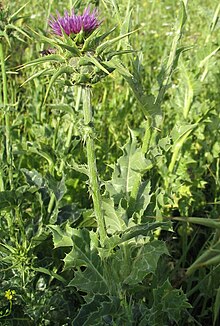Silybum
| Milk thistle | |
|---|---|
 |
|
| Silybum marianum | |
| Scientific classification | |
| Kingdom: | Plantae |
| (unranked): | Angiosperms |
| (unranked): | Eudicots |
| (unranked): | Asterids |
| Order: | Asterales |
| Family: | Asteraceae |
| Subfamily: | Carduoideae |
| Tribe: | Cynareae |
| Genus: |
Silybum Vaill. 1754 not Silybon Adans. 1764 |
| Type species | |
|
Carduus marianus L. |
|
| Species | |
| Synonyms | |
Silybon Adans., alternate spelling
Silybum (milk thistle) is a genus of two species of thistles in the (daisy family). The plants are native to the Mediterranean regions of Europe,North Africa, and the Middle East. One species has been introduced elsewhere, including in North America. The name "milk thistle" derives from a feature of the leaves, which are prominently banded with splashes of white. Historically, these milky bands were said to be Mother Mary's milk, and this is the origin of another common name, St. Mary's thistle. The most widespread species is Silybum marianum.
Many years of research show the active flavanoid-lignan (flavanolignan) group of constituents, called silymarin, contained only in the seed shell has liver-protective and regenerative properties, as well as antioxidant effects. The liver-protective effects were known and written about in ancient times, leading to the active chemical, pharmacological, and safety research beginning in Germany in the 1950s. Clinical use for a variety of liver ailments, such as hepatitis, has also prospered throughout many parts of the world.
Members of this genus grow as annual or biennial plants. The erect stem is tall, branched and furrowed but not spiny. The large, alternate leaves are waxy-lobed, toothed and thorny, as in other genera of thistle. The lower leaves are cauline (attached to the stem without petiole). The upper leaves have a clasping base. They have large, disc-shaped pink-to-purple, rarely white, solitary flower heads at the end of the stem. The flowers consist of tubular florets. The phyllaries under the flowers occur in many rows, with the outer row with spine-tipped lobes and apical spines. The fruit is a black achene with a white pappus.
...
Wikipedia
